An introduction to relief well planning, dynamic kill design: recognizing the common limitations
By Fred Ng, Wild Well Control
The recent Macondo well control event in the Gulf of Mexico has created considerable interest in dynamic kill and relief well designs in terms of contingency planning. This article addresses some of the principles, processes and engineering involved in these subjects.
Relief Well Operation
A relief well provides a means to intercept and kill a blowout well when surface intervention or capping requires an extended period of time or when that may not succeed. It is not uncommon to spud a relief well before or during a capping operation. If the blowout is successfully capped before completion of the relief well, the latter can often be converted into a replacement or additional well to produce the reservoir.
A relief well is typically drilled as a straight hole down to a planned kickoff point, where it is turned toward the target well using conventional directional technology and tools to get within 100-200 ft of the original well. The aim is to align the two wellbores at an incident angle of 3-4° for the eventual intersect (Figure 1) rather than aiming directly at the blowout wellbore.
This approach provides the best chance of success for a first-attempt intersect and allows steering of the bit for a repeated attempt instead of plug-back and sidetrack.
At this point, the drilling assembly is pulled and a magnetic proximity ranging tool (Figure 2) is run on wireline to determine relative distance and bearing from the target well. Directional drilling continues to about half the distance to the planned intersection, and another magnetic ranging run is made to update relative distance and bearing.
This process continues until the two wells are very close to intersecting. At this point, a liner is set to provide a positive alignment for penetration into the target well, as well as maximum fracture gradient at the casing seat for the subsequent dynamic kill.
The planned weight and volume of kill mud is prepared, and all pumps and fluid systems are in full readiness mode before drilling out of the liner shoe.
Dynamic kill commences immediately upon penetration of the target wellbore, and pumping continues until the blowout is dead.
Relief Well Design
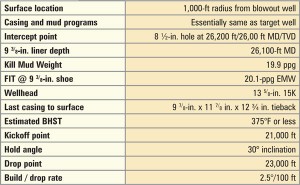
A relief well design usually involves a similar wellbore design to the blowout well, with provisions as needed for the directional trajectory, as well as an additional liner that can be set prior to intersect. Figure 3 shows the trajectory for a relief well intersecting one of several development wells drilled from a platform. A typical relief well design is given in Table 1.
Possible Design Modifications
While a parametric relief well design can be developed for contingency planning, the actual design often has to be modified and established based on the circumstances of the blowout, as well as consideration of many factors:
- Surface locations – For an offshore operation, insurance carriers for the drilling contractor typically requires that rig location for the relief well be at least 500 m from the surface location of the blowout.
- Locations are often rig specific and can be affected by bathymetry profile, geotechnical properties of the sea floor, presence of shallow hazards and any subsea facilities, pipelines, obstructions or other physical hazards on the sea floor in the affected area.
- Trajectory and intercept strategy – A surface location that meets the above conditions may not always be one that can accommodate the necessary trajectory and intercept plan.
- For example, if the target well has a hole angle above 60°, including a horizontal section, it would be difficult to run wireline tools for close proximity ranging, where the relief well must assume practically the same inclination as the target well. Dogleg severity needed to turn the wellbore in the depth and distance available may be too high for the given hole size or formation. A number of iterations may be needed to establish a suitable location and trajectory.
- Limitations in magnetic ranging – The tool relies on measuring the magnetic pattern generated by induced current in a steel object, and thus can only function when there is casing or drill string at the intercept point.
- The worst condition would be a long open-hole section with no presence of drill string or fish. The closest intercept to the blowout formation in this case would be limited to the deepest casing or liner shoe. This would require an off-bottom dynamic kill, which can be difficult to design.
- Other limitations include the temperature and pressure limits of these tools, which are currently rated for 375°F and 25,000 psi. Formation resistivity can also affect tool function. For example, it does not work in a thick salt section.
- Other considerations – Based on ocean and meteorological conditions at a given time of the year, dispersion of hydrocarbons in the water column, as well as gas plumes in the atmosphere, may limit relief well locations to certain sectors in the area around the target well.
- Rig availability and rating in terms of water and well depths, pump capacity and mud volume should be reviewed to ensure that the rig can handle the relief well operation.
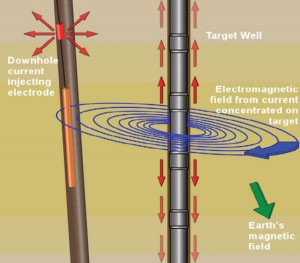
Dynamic Kill Principle & Operation
When a blowout occurs, the well unloads a stream that can include hydrocarbon liquid, gas or water flowing at a high rate, driven by a drawdown that can be thousands of psi below reservoir pressure. Dynamic kill is a process to kill a blowout by pumping heavy mud into the wellbore at high rates to suppress the flow. The process introduces kill mud into the blowout well to raise the density of the blow stream, as well as to generate considerable friction pressure in its wellbore.
The combination of these two effects eventually kills the blowout by restoring bottomhole pressure above that of the formation.
In a typical kill operation, the planned weight and volume of kill mud is prepared, and all pumps and fluid systems are kept running before drilling out of the liner shoe. Upon intersection, fluid from the relief well typically U-tubes into the target well, and all pumps are used to keep the annulus full in the relief well, followed by pumping at the appropriate kill rates until the blowout is dead.
For the case shown by simulation graphics in Figure 4, about 4,000 bbl of fluid U-tubes before pump pressure catches up as the blowout is significantly reduced. The annulus of the relief well is used for the kill operation since it offers the least friction resistance to the high kill rate. A limited amount of kill mud is pumped through the drill string, which also allows monitoring of bottomhole pressure.
Dynamic Kill Design
The multiphase flow involved in a blowout evaluation and dynamic kill design is very complex and can only be analyzed by transient flow simulations that take into account all physical effects involved. The graphics in Figure 5 show a simulation for the blowout and dynamic kill of a 28,000-ft well. It shows the well unloading until a steady-state blowout is established at about the 60-min mark.
Dynamic kill is initiated and pumped until completion, with the four windows on the left displaying pressure and flow rate data for the blowout well, and three on the right showing behavior of the relief well.
The simulations described in this article are run with the “OLGA Advanced Blowout Control” simulator (OLGA-ABC), which was developed in a cooperative effort between Wild Well Control and Scandpower’s SPT Group. It involves the latest technology in transient multiphase simulation and is particularly useful for today’s deep, high-temperature, high-pressure and prolific wells. Design results from the simulation shown in Figure 5 are summarized in Table 2.
While a parametric dynamic kill design can be developed for contingency planning, the actual design often has to be modified and established based on the circumstances of the blowout event, as well as consideration of many factors.
• Blowout rate – This depends heavily on reservoir properties, wellbore conditions and the scenario to be addressed, and is simulated as part of the dynamic kill design. For example, it can be an unrestricted or restricted flow and can range from blowout above the water line for a jackup to an uncontrolled flow from a wellhead on the sea floor.
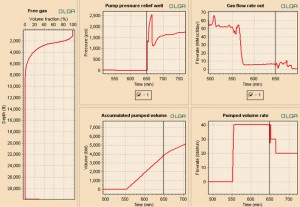
• Off-bottom kill – Depending on the distance of the intersect above the blowout zone, the required pump rate, kill mud weight and equivalent circulating density (ECD) for an off-bottom kill will all be significantly higher than for a kill on bottom. For example, kill mud weight and ECD can both exceed formation fracture gradient in open hole, resulting in massive losses. If identified by simulation runs during the planning phase for the original target well, this problem may be addressed by running a deeper or additional string of casing or liner. Otherwise, options may be very limited if a blowout occurs.
• Pump rate control – After the initial U-tube, pump pressure rises steadily as kill mud continues to fill the blowout wellbore. Pump rate must then be reduced in order to maintain wellbore pressure below fracture gradient and to keep pump pressure within ratings of the surface equipment. In the case shown in Figure 5, the operator had set a pump pressure limit of 7,500 psi, and the simulation shows how pump rate can be continuously stepped down to match same.
• Optimizing kill parameters – A dynamic kill can involve a number of limitations and independent design parameters. Principle limits include fracture gradient of the formation, pressure and hydraulic horsepower of available pump spread, mud-mixing and storage facilities, available vessels and support infrastructure for the operation.
The main design parameters include intersection depth, kill mud weight, pump rate and step-down schedule. The simulations allow iterating with various combinations of these parameters to design a kill within the limitations. This can result in an optimized kill design or, in some cases, identify a unique combination that can be implemented to kill the blowout.
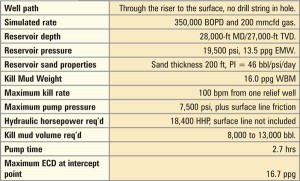
• Dual relief wells – A very prolific reservoir, off-bottom kill and high formation pressure, or a combination of these, can form a scenario in which pump rate and pressures exceed the ratings of normally available equipment. One option is to conduct the kill operation through two separate intersections by two relief wells, which cuts the pump rate per well by half and should reduce pump pressure by about 70%. It may not be possible to synchronize simultaneous intersects, so continuous pumping of sea water or mud will be necessary after the first intersect to maintain control until the second intersect is made. At that point, kill mud can be pumped through both wells.
Except for one related case where two relief wells were drilled to kill two separate zones, it is not clear that such a dual relief well-kill operation has been conducted. Although technology and equipment are available, substantial engineering and planning will be needed to do so.
• Bridging of a blowout – Experience from recent years in the Gulf of Mexico and Gulf Coast region indicates that blowouts involving a significant open-hole interval usually bridged over, before or during wellhead intervention, and typically within about 10 days of the initial event.
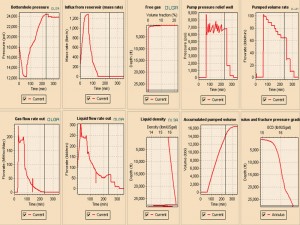
Simulations confirm that, due to the typically large induced drawdown, wellbore pressure gradient in an open-hole blowout typically falls below the collapse gradient of the open formations. This condition is consistent with the above experience on bridging. Such results may help to define a limited drawdown for the worst-case flow rate in a sustainable blowout, or otherwise used to provide additional evaluation of the risk for a sustained blowout.
CONCLUSION
Although the basic principles involved in relief well and dynamic kill operations are not complicated, their design and implementation can involve quite a few limitations that may not be commonly recognized. Engineering analysis and simulations can play a significant role in reviewing these limitations and designing these operations.
Establishing parametric designs for both as part of contingency planning can provide significant confidence for the feasibility of these operations, as well as facilitate implementation should they be needed to resolve a well control event.
Acknowledgment: Fred Ng wishes to thank Vector Magnetics for use of the graphics in Figure 2 of this article. Mr Ng is general manager, engineering, at Wild Well Control.







I would like to know the static kill and dybamic kill methods in detail
thanks, regards
Very useful article, it summarizes most of the principles of Relief Well Planning, and helped me clear some of the concerns in the RWP I’m currently preparing.
Appreciated.